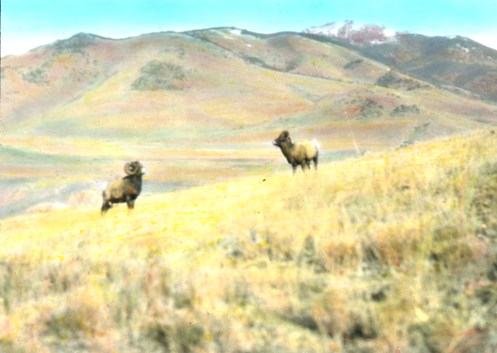
Today’s picture is from the Yellowstone Museum Collection, YELL 15831. The original is a lantern slide picture taken by a park employee in December, 1929.
NORTH ENTRANCE
The north entrance (via the Northern Pacific) is at Gardiner, Montana, where the lava arch gateway was constructed in 1902, at a cost of ten thousand dollars.
Gardiner is 54 miles from Livingston, Montana.
WEST ENTRANCE
The west entrance (via Union Pacific and Oregon Short Line) is at Yellowstone, Montana, 292 miles from Ogden, Utah, and 328 miles from Salt Lake City, Utah.
GEOLOGY
The whole region has witnessed tremendous volcanic activity at a comparatively late geologic epoch, and the results of this activity, in the form of geysers, thermal springs, terrace and crater formations, cliffs of obsidian, deeply eroded canyons, petrifications, sulphur hills, solfataris and the like, are of the strangest and most startling description. In that epoch, lava was piled up on the Park plateau to a depth of 2,000 feet.
While the volcanic activity and attendant heat belong to another age, the present high temperature of the subterranean rock is believed to be resultant from that activity. It is the contact of these super-heated rocks with the snow water which has percolated downward thru the fissure veins that produces the varied geyser and hot spring action. It is these manifold manifestations of hydrothermal activity and the eroded canyons, that has made Yellowstone the "Wonderland of the World."
Most visitors are surprised to learn that eighty-four per cent, of the area of the Park is forest, chiefly black pine, red fir, balsam, cottonwood and Englemann spruce. Scattered everywhere on open plain, mountain slope and in the forests, in endless profusion, are wild flowers of over two hundred kinds and almost as many hues.
ANIMALS AND BIRDS IN YELLOWSTONE PARK
To many visitors the sight of wild animals, elk, deer, antelope, bear and smaller animals in the woods and meadows, in the natural state and without fear, is one of the most enjoyable experiences of the trip.
Within recent years the increase in the number of wild animals in the Park is very noticeable. The careful protection accorded them gives them opportunity to multiply, and besides many bears and buffaloes, there are, approximately 2,000 antelope, 200 mountain sheep, l00 white-tail, and 1,000 black-tail, deer, and thousands of elk roaming the Park. The animals offer to molest no one, and are harmless when no attempts are made to annoy or interfere with them. The elk, and particularly the deer, are not infrequently seen near the roadsides and grazing in the vicinity of the camps and hotels.
The tourist season in the Park is the annual feast time or vacation period for the bears. Morning and evening they frequent the garbage heaps and wax fat and sleek upon what the hotels throw away. Then the tourists flock out to watch and kodak them, and a great amount of fun is derived from the antics of the beasts.
Early in the fall the animals come down from the hills and remain in the valleys during the winter and spring. During this time the traveler who will run up to Gardiner from Livingston for a day or two will see on the flats and hills around Gardiner and Mammoth Hot Springs many mountain sheep, antelope, deer and elk. The sheep, antelope and deer are often thus seen by the hundreds.
Within recent years many of the antelope have remained during the summer to graze on the alfalfa field at and within the north entrance at Gardiner, where they may be seen by tourists.
The buffalo, or bison, are in two herds. Those indigenous to the region are found in a remote part of the Park, and number perhaps twenty-five or thirty. Within recent years a fresh lot of these animals was bought by the government and placed on Lamar river in the northeastern part of the Park, These late arrivals have multiplied and replenished the species, and the success already attained is very encouraging. The herd is steadily increasing, now numbering nearly one hundred.
Mountain lions, which once were quite numerous in the park, are now but few.
There is a colony of moose in a remote part of the Park.
It is pleasing to know that the beaver, once so important a part of animal life in the West, are rapidly increasing in the streams of the Park. Almost every stream shows signs of their presence, and about Tower fall there are several colonies of them occasionally seen by tourists who visit this locality.
Of birds there are many, geese, ducks, pelicans, gulls, eagles, hawks, owls, night hawks, ravens, Rocky Mountain jays, tanagers, bluebirds, water ouzels, blackbirds, meadow larks, robins, and others.
